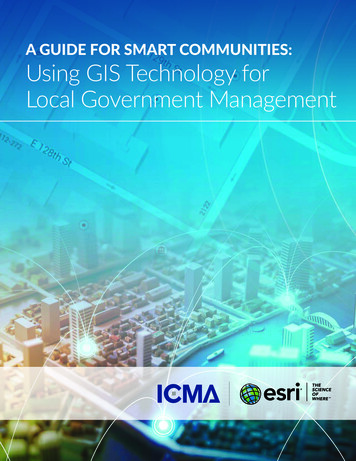
Transcription
A GUIDE FOR SMART COMMUNITIES:Using GIS Technology forLocal Government Management
ICMA, the International City/County Management Association, advances professional local governmentthrough leadership, management, innovation, and ethics. ICMA provides member support, publications,data, and information; peer and results-oriented assistance; and training and professional developmentto more than 10,000 city, town, and county experts and other individuals and organizations throughoutthe world. The management decisions made by ICMA’s members affect 185 million individuals living inthousands of communities, from small villages and towns to large metropolitan areas.Esri builds ArcGIS, the world’s most powerful mapping and spatial analytics software. The companybelieves The Science of Where can unlock data’s full potential in every organization. For local governments looking for ways to build safe, healthy, and resilient communities for their constituents, mappingand analytics using GIS offer new insights for delivering services more effectively and engaging residentsmore fully. GIS technology gives governments and their citizens access to the information they need tomake more informed decisions. To learn more about Esri, please visit esri.com.Copyright 2018 International City/County Management Association, 777 North Capitol Street, N.E.,Suite 500, Washington, D.C. 20002. All rights reserved, including rights of reproduction and use in anyform or by any means, including the making of copies by any photographic process or by any electronicor mechanical device, printed or written or oral, or recoding for sound or visual reproduction, or for usein any knowledge or retrieval system or device, unless permission in writing is obtained from copyrightowner. Cited Internet sources were valid as of October 2017. Because URLs and websites are constantlychanging, we cannot vouch for their current validity.To locate other ICMA print and digital publications, please visit icma.org.
ForewordWe live in an age of tremendous creativity and innovation. For local governments, this meanstaking new approaches to problem solving. Seeing the big picture but understanding all theinterconnected details. Adapting quickly when necessary but simultaneously keeping the longrange view of a resilient and sustainable community.Beyond that, innovation requires us to shake things up and do things differently. It’s not justabout brainstorming or blue-sky thinking. It requires taking advantage of employee experienceand competence, and then considering how local government processes, procedures, and systems could or should work. It’s based on understanding what our residents expect when theyinteract with government.Esri has worked with the International City/County Management Association (ICMA) for overtwenty-five years to encourage creativity and innovation in local governments. A geographicinformation system (GIS) enables government staffs to easily tap into existing data and citizenfeedback and to use that information to answer the most important questions about what isbest for the community. This guide shows you how a local government can create new efficiencies, generate cost savings, demonstrate return on investment, and engage everyone usingGIS. We’ll explore how 2D and 3D GIS help developers and residents alike understand real andpotential impacts of a new development. We’ll share the power of storytelling with maps andhow a simple mobile strategy leads to real-time decision making.We have moved from the Information Age to the Innovation Age. Our future lies not in collecting and processing data, but instead, defining the challenges faced by local governments andanalyzing what policies will produce the desired results. Smart communities must approachtechnology with creative minds. This guide highlights how location intelligence is enablingcommunities to respond faster with more confidence and understanding.Jack DangermondFounder and PresidentEsriA GI S GU I DE FOR S M A RT COM M U NI TI E S1
Defining Smart Communities:The Journey to a City of the FutureAmy Ahner, Director of Administrative Services, Village of Glenview, IllinoisThe Smart Cities movement has garnered tremendous attention from local governmentleaders over the past five years, but what do we mean by a “smart city” or a “smartcommunity”? For some communities, becoming a smart city is all about technology andintegrating it into the daily operations of local government departments. It’s havingaccess to real-time data for work crews in the field. For others, it’s about automatingsystems, enabling residents to make service requests from their smartphone or on thegovernment’s website. Or perhaps it’s becoming the “paperless office” that we’ve allheard about for the past two decades.
At this moment in time, however, there is nosingle universal definition of what it takes to be asmart community though there are many organizations and businesses dedicated to exploringthis topic. In response to member interest inthis topic, ICMA formed the Smart CommunitiesAdvisory Board. Board members have a stronginterest in providing new content and education to enable our members to become IT-savvymanagers. Defining what it means to be a smartcommunity for their jurisdiction is part of thejourney to becoming a smart community.Implementing technology for technology’ssake or because of a desire to keep up with thecommunity next door is not smart. Local government managers need to first identify whatchallenge(s) or problem(s) they want to resolvein the community. Only after this has been doneshould a community begin to consider technology options. Technology should not drive purchasing and implementation decisions, but ratherit should be used to address community challenges or achieve desired goals. For example, inDubai, officials want the city to be the “happiestplace on Earth”—definitely a goal that requirescreativity and innovation to address. But the cityis well on its way to achieving this goal. Localgovernment leaders have installed HappinessMeters throughout the city to enable residentsto rank their happiness with everyday services.In the case of a city manager in Florida, the thingthat keeps him awake at night is the desire for hiscommunity to “not to become the next Atlantis.”He has seen the effects of climate change atwork in his community and wants to reverse theeffects as well as prevent more problems.Such goals may seem lofty, but they offera clear understanding of what the communities need from technology. Smart communitieshave an overriding purpose that leaders wantto address. To do so, they establish milestonesand track metrics to determine their progress.They ask questions to determine what needs tohappen for the community to achieve its goals.4A G I S G U I D E FO R SMART CO MMUNIT IE SSee how Fairfax County, VA,uses 3D GIS to understandhow new development affectsthe community.Considering the rapid pace of technological anddigital change, what questions should a manager be asking when the discussion turns to thetopic of smart communities? Here are a few foryour consideration:Managers ask about what they can do to keepsystems secure from security breaches. Do our current technology policiesaddress social media use and storage? What are our data breach notificationrequirements? How are we securingpublic data? What is our greatest risk or weakest pointin the network, and what should we do toaddress it? Do our current policies and proceduresemploy best practices to connect devicesto the network?Managers ask about strategies to implementthe technology and to change operations. What can we do to increase connectivityand speed by expanding broadband and/or fiber optic networks in the community?Who are the providers? How are we integrating communications with the capitalimprovement plan? What investments in the infrastructurebackbone would we need to a support aseries of networked cameras or a dashboard initiative to track performance? If the community wanted to organize acrowd-funding project, what technologysupport would be necessary? Should we host a hack-a-thon?
Managers ask about technology trends to stayahead of the curve. What services can be migrated to thecloud? Does our current cloud serviceprovider meet the FedRAMP governmentsecurity standards? Do we meet international standards fordata backup and disaster recovery andhave we documented that goal in a plan?Managers think about their community purposeand ask how technology can enrich it andachieve desired goals. What smart city projects align with ourcommunity vision (trendsetter, moderncity, quiet suburb, etc.)? What would enable greater communica-tion between citizens and public services? Can GIS and smart technology be used toattract economic development and talent?Managers ask about how to store and use data. What collected and stored data is public How can data be accessed easily and usedto measure performance?The IT-savvy manager understands that smartcommunities have a purpose. Communities arenetworks of institutions that work together toaddress social and economic issues. These managers also understand the importance of adopting six foundational pillars on which to build tobecome a smart community:1. Organize your data.2. Improve operational efficiency.3. Emphasize civic engagement.4. Develop a “mobile first” mindset.5. Provide the tools for data-driven decisions.6. Set up the infrastructure for the Internetof Things (IoT).This guide reviews specific GIS trends andcommunity projects that use relevant dataand innovative technology to improve servicedelivery and decision making, which may bevaluable to jurisdictions on the path to becomingsmart communities.and what is private? Do we need a dataclassification policy? Can predictive analytics be used toaddress community problems? How can data help us better understandhow staff is spending their time?A GI S GU I DE FOR S M A RT COM M U NI TI E S5
Trends in the Use of LocalGovernment Data and TechnologyProfessor Stephen Goldsmith, Daniel Paul Professor of the Practice ofGovernment and Director of the Innovations in American GovernmentProgram at Harvard’s Kennedy School of Government.No sector will benefit more from digital disruption and tools than a government led by asenior manager committed to using available technologies to drive higher-quality services tocitizens. We are at a once-in-a-century opportunity for dramatic change, yet that change restson concepts in part foreign to government. These digital tools envision a distributed systemwhere information is broadly spread over agencies, neighbors, and sectors. Creating insightfrom this information will provide the opportunity for managers to drive more and betterorganized data to the field.
Enormous technological changes in the lastfew years alone have made GIS platforms andtheir related solutions indispensable in producing changes in the quality of life in communitiesaround the world. While these changes affectall sectors, I view them through the lens of thepublic sector, having spent thirty years in orinvolved with local government. Officials nowpossess powerful tools to improve outcomes,responsiveness, and civic engagement that wereunimaginable as little as five years ago. And yet,these tools will only reach their potential if wecan figure out how to integrate them into day-today governance.Let’s look first at some of these technologybreakthroughs and the challenges that inhibittheir application. At the most basic level wesimply have more potentially useable datathan organizations have capacity to effectivelyutilize. Four big trends reflect this opportunity/challenge gap:1. The movement from analog to digitalhas produced massively more data butthat data are often trapped in the transactional, siloed systems utilized by a singlecity agency.2. Mobile devices allow field workers accessto critical information in real time, whichcan enhance their problem-solving abilities—but only if it is organized in a mannerrelevant to the area in which theyare working.3. Social media provides opportunities forcommunity engagement in the coproduction of city services but, again, only ifthe observations are curated and taggedgeographically.4. Cloud computing and open-source codeallow workers in one city to benefit fromapplications developed in another—if thelatter officials share a similar GIS platformand a commitment to openness.Government can play an important role inunlocking knowledge. In my recent book, A NewSee how the city ofSan Antonio, TX uses GISto tell the history ofThe Alamo and missions.City O/S: The Power of Open, Collaborative, andDistributed Governance, we call out Los Angeles’sGeoHub as one powerful example of how citymanagers can build these foundations. In LosAngeles, the GeoHub organizes public data ona well-visualized GIS platform, allowing publicemployees to see what other agencies are doingin a given geographic area and allowing residentsto gain more knowledge about and contributeto solutions in their neighborhood. Much of theGeoHub data can be utilized and analyzed bycitizens, who can fully see what activities andchallenges are occurring in their community and,as a result, make contributions that can be easilyconnected to public employees’ stream of work.In one such initiative, Vision Zero, Los Angeleshas provided easily visualized data from variousagencies and made the insights available to residents as part of a citywide initiative that concentrates on pedestrian and bike safety. Here LosAngeles is taking massively more available digitalinformation, integrating it across departments,visualizing it for community participation, and, inturn, improving the insights of its city workers.The open data movement further reinforcesthe importance of GIS as an organizing platform. A few years ago, residents could not seereal information about how their governmentresponded to various issues. In the early daysof open data, some cities provided reports tothe public but not in a way that was meaningful.Imagine the difference between a spreadsheetof city data on street and sewer repairs and ahigh-quality, well-designed map reflecting complaints and the time to resolution, revealing cleartrouble spots and service areas. This evolvingopen data movement will next add even morevalue when it takes city enterprise performanceA GI S GU I DE FOR S M A RT COM M U NI TI E S7
data and integrates the observations of citizens.Thousands of unorganized and often ignoredcomments add little more than frustration unlessthey are also curated and GIS tagged. The GISplatform provides context, allowing an organization to produce more value from its other ITexpenditures—an important benefit for cashstrapped public entities.The digital revolution includes the Internet ofThings (IoT), where things like streetlights, peoplewith wearables, and smartphones are constantlyconnected. Data produce understanding whencontextualized. A city that can organize and mine8A G I S G U I D E FO R SMART CO MMUNIT IE Sthese types of data, giving it geospatial relevance,will jump ahead in terms of responsiveness.GIS today can turn data into the knowledgenecessary to produce value. When data areorganized geographically and effectively visualized, they tell a story that will drive both resultsand policy, as well as engender the civic supportof citizens. Trust in government can be renewedthrough accurate information that leads toenhanced responsiveness. GIS is context, literallya civic switchboard knitting together that whichwill produce a high quality of life.
Got Data? Visualize It to Get ResultsLori Sassoon, Deputy City Manager/Administrative Services,City of Rancho Cucamonga, CaliforniaWe took a fresh look at the business of the city and how we deliver services. Thatintrospection resulted in developing a mobile app strategy to better reach citizenswhere they are and help them communicate with us. A key component of this strategyis GIS. Maps and place-based information resonate with everyone, from citizens tomanagers to elected officials, regardless of the communication channel, enabling all ofus to work on and solve community problems together.
Public works, police, fire, recreation, libraries,social services—all the essential functions oflocal government involve collecting all sorts ofdata. Often the data sit in disparate computersystems and even in paper files. It’s a treasuretrove of information, and it can be hard to wrapour arms around it all. In the meantime, we’reall looking for ways to use that data to evaluate our performance and help solve importantproblems in our communities.GIS provides a platform to organize our dataand visualize it in ways that make it useable toindividuals and teams. Before going out to collectmore data, our team first reviews what data arealready being stored and maintained, and thenuses that information to make data-driven decisions about resource allocation, policy development, and personnel deployment.The city of Rancho Cucamonga has made apractice of fostering the use of its existing datafor new innovations whenever it can. For example, data collected during processing permits andbusiness licenses are cleaned and used in thecity’s RC2GO mobile app to direct citizens tolocal restaurants and other area small businesses.Like Rancho Cucamonga, many local governments and public agencies have used GIS toolsin creative ways. The following is a selection ofpopular GIS tools for local government managers.Learn how the city of RanchoCucamonga, CA uses mobileapps to provide services toits residents.DashboardsDashboards provide a quick visual reference ina familiar way. Dashboards draw from differentdata sets. When the data are displayed alongside one another and in real time, they providea comprehensive view of operations and what’shappening in the group. Rancho Cucamonga’scity manager and other leaders use an executive dashboard that showcases police and fireincidents, vehicle locations from the automaticvehicle location (AVL) system, and citizenrequests for service. Users can drill down intothe data to learn more details, such as finding outthe location of a fire incident or seeing photosof the incident that were uploaded on the scene.The executive dashboard is an app accessible onsmartphones and tablets.Creating DashboardsThe Rancho Cucamonga’s GIS Team worksclosely with city staff to understand workflowsand other needs of the city departments. OnceTable 1. City of Rancho Cucamonga, Popular Public ApplicationsData Set(s)AppDescriptionService RequestRC2GO Mobile App(iOS / Android)Allows residents to report issues aroundthe city, and city services can respondquickly.RC Major ProjectsCity Projects and PrivateDevelopmentDisplays the major improvement projectsand developments taking place aroundthe city.Public ParcelsMy CommunityAllows residents to look up informationrelated to properties around the city.This includes zoning, general plan, trashpickup day, school district, etc.10A G I S G U I D E FO R SMART CO MMUNIT IE S
Table 2. City of Rancho Cucamonga, Popular Internal ApplicationsData Set(s)AppDescriptionService Request, Incidents, InspectionsExecutive DashboardAllows executive staff and departmentleads to view live data from multiplesources. Popular examples include fireincidents, resident service requests, andcity inspections.Service Request, Sidewalk InspectionsConcrete RepairsUsing information gathered from RC2GO,this app allows Public Works crews to respond to damaged sidewalks around thecity. Work crews use mobile devices toview and update the status of locations.Before and after photos are taken aswork progresses. Office staff monitor andupdate inspections in the field and anoverview of all inspections can be viewedby superintendents and supervisors.Service Request, Graffiti RemovalGraffiti RemovalService Request information fromRC2GO identifies graffiti reported by residents. Field crews using mobile devicesrecord removal activity and update theservice request status. Photos are takenof the graffiti before removal and PoliceDepartment personnel review these forgang-related activity.the needs are identified, the team brainstormsand develops different solutions. Rolling thesesolutions out to city staff requires that the applications be tested against staff workflows. Thenstaff are trained on how the application(s) works.Our GIS staff allow users across the enterpriseto log in and access GIS maps, apps, and data.Setting up and deploying a dashboard is a quickprocess. We select a dashboard theme and thenwe target a map and data set within the organization. For the data to be “live,” field staff updatethe data using mobile devices. Office-basedpersonnel can also update the same data.Story MapsEsri story maps take a map to the next level, bringing in more details and information than could beseen in a traditional paper map. As a multimediaA GI S GU I DE FOR S M A RT COM M U NI TI E S11
experience, story maps are accessed online. Userscan drill down in the map to see more details,photos, and even video to provide a more complete and compelling picture. Residents can accesslinks on the city’s website for quick retrieval.Our GIS staff use story maps in a number ofways. We have also trained many non-technology staff members in various departments tocreate their own story maps. Among the subjectswe’ve covered are military banner locations,public art, and pending development projects.San Bernardino County’s economic development staff created a rich story map with videoand photography elements that showcases thecounty’s craft beer, food, and nightlife in a freshand modern way.ArcGIS for Stable Local Government SolutionsGIS novices can create a story map in a matterof hours once the story to be shared has beenorganized. Application templates can be customized to the jurisdiction’s needs. Esri providestemplates on a wide variety of topics. Amongthe topics that Rancho Cucamonga has usedare Land Records, Address Management, PublicWorks, Emergency Management, and Planningand Development. Other useful application templates include Crowd Source Reporter, CrowdSource Manager, Web AppBuilder, and Dashboard Themes.12A G I S G U I D E FO R SMART CO MMUNIT IE SData AggregationGIS lets users pull information from disparatesystems and display the data together in digitaland paper maps. For example, library user datafrom the library management system might beviewed on a map along with recreation class registration from a separate software system to seeif patterns of use emerge.Creating Aggregated DataThe GIS Team exports data from different systems into ArcGIS Online. This allows differentdata sets to be brought together, viewed, andmanipulated by city staff. GIS enterprise platforms provide the tools to use our data in thesehighly effective ways.Not all agencies have staff with the neededGIS skills to maximize the use of these tools.Throughout the Midwest and down to Texas,many local governments have opted to establishregional GIS services. A regional GIS solutionenables smaller jurisdictions and agencies topool resources and share their expertise. RanchoCucamonga provides GIS services to smallerpublic agencies across California, helping them toramp up their GIS programs and show police, fire,public works, planning, and other departmentshow GIS can help them manage and use theirdata for improved decision making and workflow.With regional and shared-service approaches,the resource and expertise barriers for using thetechnology become lower for even the smallestof agencies.
ResourcesNo.Publication NameSourceBrief DescriptionLink1Best PracticesFor LocalGovernmentGeospatialProgramsFederalGeographic DataCommittee(FGDC)This article gives somecommon elementsthat contribute to afoundation on whichsuccessful local government geospatialprograms are -best-practices-paper.pdf25 Innovative WaysMunicipalities UseGISGovPilot.comAn introduction tohow GIS is lettingcitizens engage withtheir governments ininnovative new ys-municipalities-use-gis3Keeping LakeLake County,Beautiful with aFloridasimple to useMobile ApplicationA case study aboutLake County’s Geographic InformationServices (GIS) Divisionworking with KeepLake Beautiful, anaffiliation of KeepAmerica Beautiful, tocreate a mobile application that allowscitizens to submitproblems and observations around ase study keeplake beautiful crowdsourcereporter.pdf4GIS CollaboratesLake County,with the Property FloridaAppraiser to createDigital Tax MapsA case study abouthow Lake County’snew PropertyAppraiser is using GIStechnology to bringaccurate and up-todate digital tax mapsto citizens, developers,and ase study digitaltax maps.pdfA GI S GU I DE FOR S M A RT COM M U NI TI E S13
No.Publication NameSourceBrief DescriptionLink5My Public Services Web AppHelps LocateValuable ServicesLake County,FloridaA case study abouthow Lake CountyGIS implements theMy Public Servicesweb map applicationin collaboration withcounty municipalities; the app allowsthe user to locate anaddress and see various public servicesand facilities that se study my public services.pdf6GIS’s EvolvingPromise for LocalGovernmentGoverningThe development ofGIS technology inLoudoun County, VAand how it improvesdecision making andhelps guide .html7Exploring the Cityof Darwin MapPortalGIScloud.comAn insight into citizenengagement with thehelp of public maps inthe City of city-ofdarwin-map-portal/8GIS Web MappingEnables Self Service - and SavingsDirectionsMagazineContinuing developments in GIS technology, specifically inweb mapping, provide both more costeffective means ofdelivering customerservices and measurable improvements incustomer satisfactionthrough smart, selfservice 0314A G I S G U I D E FO R SMART CO MMUNIT IE S
No.Publication NameSourceBrief DescriptionLink9Cutting costs,expanding transparency are goalsof Colorado's newGIS portalStatescoopColorado released ageospatial portal thatshowcases geospatialservices and transforms how stateagencies use andunderstandtheir ortalto-cuts-costs-expand-transparency10GIS Helps Communities Showcase UniqueStrengthsGovernmentTechnologyIn an era of unprecedented competition,municipalities turn tonew mapping tools toaggressively marketand sell to targetedbusiness ana CityMakes ElectionData AvailableThrough GISGovernmentTechnologyEast Baton RougeParish has combineddata from the Louisiana Secretary ofState’s office withits online maps toallow users to viewprecinct-by-precinctelection GIS Story MapsUniversity ofDelawareAn introduction toGIS story maps andwhere and how theyare used in g/planning/gisstory-maps/13In-Depth Survey/Interviews withLocal GovernmentGIS LeadersNYC Geospatial Information Systemand MappingOrganization(GISMO)Results from survey/interviews withthirteen local government GIS mergingGIS Interview Summary.pdfA GI S GU I DE FOR S M A RT COM M U NI TI E S15
No.Publication NameSourceBrief DescriptionLink14MassGIS projectsshowcaseMass.govA showcase of howMassGIS has completed a variety ofanalysis projects forvarious agencies.These projects oftensupported significantlegislative or ails/massgis-projectsshowcase15How GIS CanSave Money andIncrease Efficiency for CitiesWestern CitiesThe City of SantaRosa has discoveredseveral fiscal advantages in using GISsoftware to managemunicipal assets;handle data relatedto these assets; andprovide better information for residents,business owners,policy-makers, ency-forCities/16An Analysis ofBenefits from Useof GeographicInformationSystems byOzaukee County,WisconsinOzaukeeCounty LandInformationOfficeThis document analyzes the benefits ofthe Ozaukee CountyLand InformationProgram by a detailedaccount of the County’s demographicinformation, the GISprogram, availabledata sets, goals, andobjective as well asthe cost benefits ofGIS to the -of-GIS171000 GIS Applications &Uses – How GISIs Changing theWorldGIS GeographySummaries of GISapplications from 50different -uses/16A G I S G U I D E FO R SMART CO MMUNIT IE S
CitizenengagementGIS: HELPING GOVERNMENTSOpioidepidemicBUILD SMART COMMUNITIESLocal economicdevelopmentPromoting Prosperous CommunitiesGIS SolutionTackling Social InequitiesGIS SolutionPrioritizing Community EngagementGIS SolutionLocalEconomicDevelopmentOpioid EpidemicCommunityEngagementCommunity engagement requiresmeeting constituents wherethey are. GIS technology offersinnovative solutions that make iteasier for community members toparticipate. There are apps thatmake it possible to direct citizensto voter polls with the shortestlines or for residents to providefeedback on strategic plans online.In the public health field, theopioid epidemic has resultedin the overdoses of thousandsof people across the country.Using GIS technology, localgovernment can track thelocation of Rx disposal stations,collect overdose data for locatingtreatment centers, and monitorNarcan
best for the community. This guide shows you how a local government can create new effi-ciencies, generate cost savings, demonstrate return on investment, and engage everyone using GIS. We'll explore how 2D and 3D GIS help developers and residents alike understand real and potential impacts of a new development.











